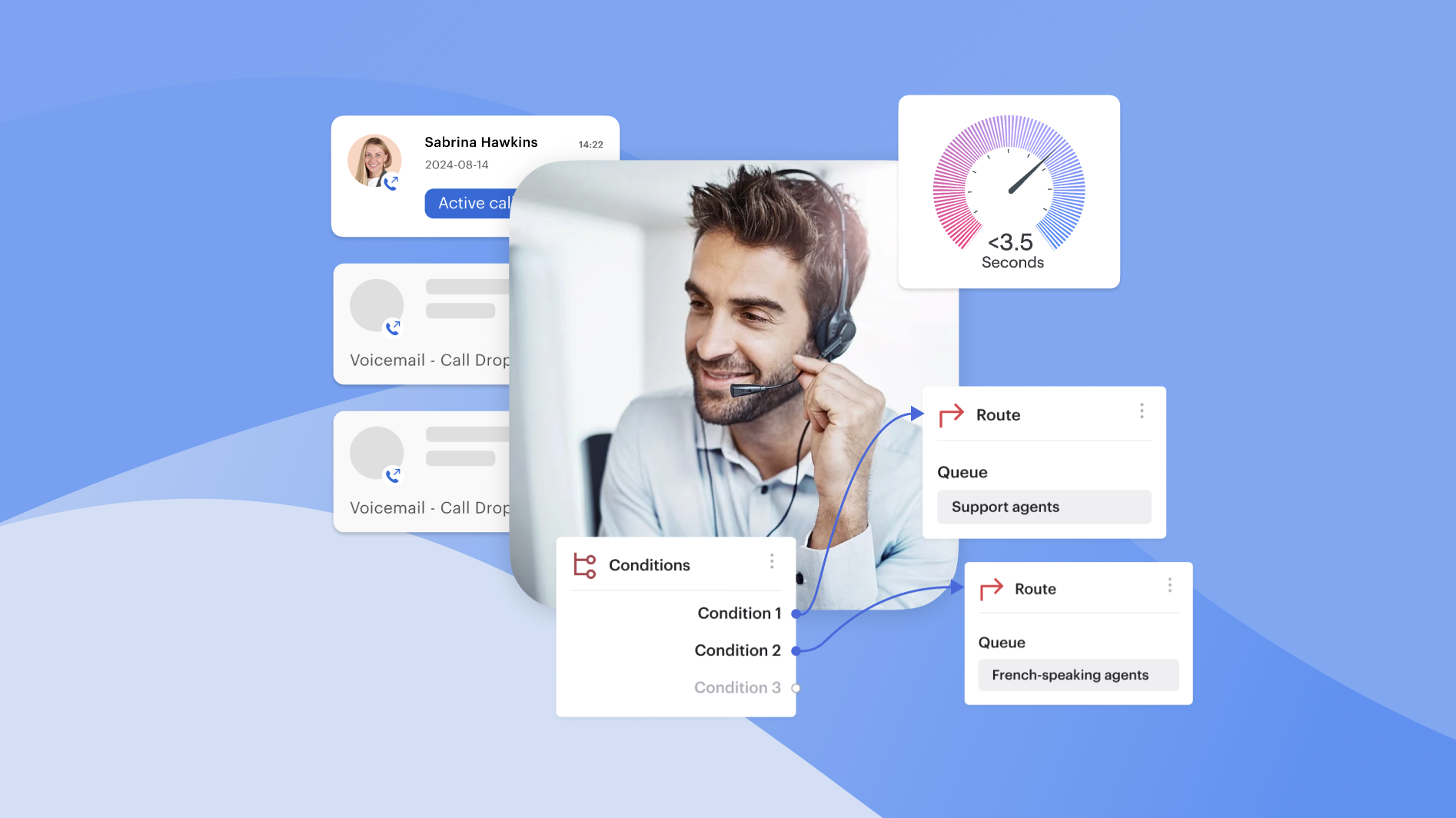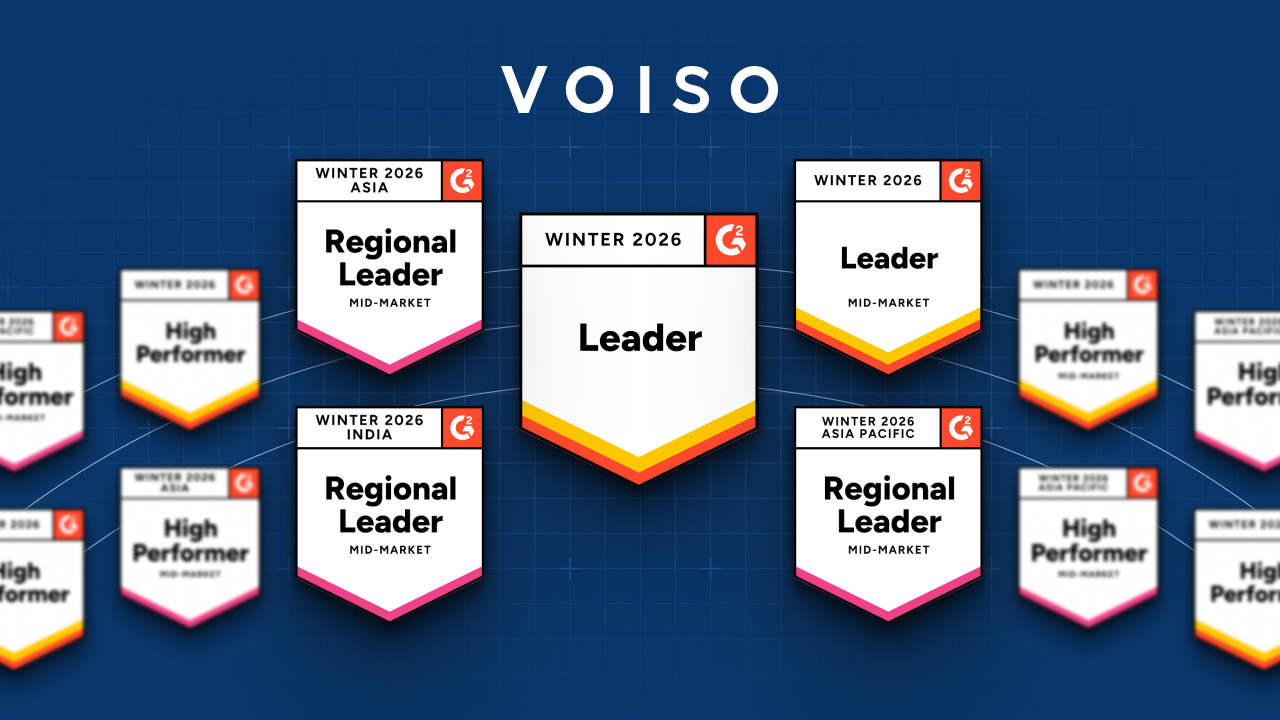When done right, modernization can do so much more than streamline your processes; it can bring CX to another level, enable quicker issue resolution, provide omnichannel support across all communication platforms, and keep the business agile and ahead of the competition.
Let’s explore how you can modernize your contact center successfully.
Takeaways: Modernizing Your Contact Center
- Why modernize: Elevate CX, improve resolution times, enable omnichannel support, reduce costs, and keep the business agile and competitive.
- Cloud-based solutions: Offer scalability, flexibility, remote access, and cost savings while reducing dependence on on-premises hardware.
- AI and automation: Streamline workflows, reduce manual admin, improve CX, and provide self-service options via chatbots, IVR, and virtual assistants.
- Omnichannel communication: Unify phone, email, chat, SMS, and social media interactions to provide seamless, context-aware customer experiences.
- Data analytics and insights: Track metrics, analyze trends, and use predictive analytics to proactively optimize operations and improve customer satisfaction.
- Workforce management tools: Forecast call volumes, schedule staff efficiently, monitor agent productivity, and foster accountability through real-time dashboards.
- Modernization process: Evaluate current systems, define goals, research vendors, implement new technologies with training, and continuously monitor and optimize.
- Improved customer satisfaction: Personalized interactions, faster responses, and reduced wait times enhance CSAT and NPS scores, building loyalty.
- Increased efficiency and cost savings: Automation, AI, and cloud platforms reduce labor costs, optimize workflows, and minimize operational overhead.
- Enhanced flexibility and scalability: Quickly adapt to demand fluctuations, support remote teams, expand markets, and integrate additional tools as needed.
- Next steps: Explore solutions aligned with your needs, consult experts or vendors for demos, and create an implementation roadmap to ensure smooth modernization.
- Overall takeaway: Contact center modernization combines cloud, AI, omnichannel support, and analytics to deliver better service, operational efficiency, and long-term competitive advantage.
Why Modernize Your Contact Center?
Customers have always expected high quality service. But thanks to digitization, customer service expectations are higher than ever. People want instant support across multiple platforms that’s not only efficient, but personalized. Companies that fail to adapt risk losing a massive portion of their customer base to competitors that are continuously modernizing their processes.
Introducing technologies like AI, cloud-based platforms, and omnichannel solutions creates the smoother, faster, more tailored experiences that customers crave. It goes beyond simply keeping customers happy – it’s about setting your business up for lasting success. Streamlining workflows and introducing real-time analytics results in faster resolution times, lower operational costs and a much more productive team overall.
Service quality drives customer loyalty, making contact center modernization a necessity for any business hoping to stay competitive.
Key Technologies for Contact Center Modernization
Cloud-based solutions
The main benefit of cloud-based solutions for call centers is their unparalleled flexibility and scalability. Traditional systems require hardware and on-premises maintenance, making them a more limited option, especially as customer demands fluctuate.
Cloud-based solutions, on the other hand, are the complete opposite: they allow call centers to scale their resources up or down based on a variety of factors like call volumes, seasonal changes or business growth. They’re much more cost-effective as they don’t require physical hardware, and are ideal for remote companies as they can be used from anywhere in the world, as long as agents have a stable internet connection.
Cloud-based systems not only modernize call centers, they optimize their capabilities by opening the door to endless new markets.
AI and automation
Artificial intelligence (AI) and automation are instrumental in transforming contact center operations. They streamline workflows, improve CX, speed up resolution times, cut down on operational costs, and get rid of manual admin for agents.
Tools like chatbots handle common inquiries like FAQs and account queries using natural language processing (NLP), while IVR menus empower customers to help themselves with self-service options. AI has changed the face of customer service with virtual assistants that resolve issues quickly and easily, reducing both response times and operational costs.
The benefits are endless – automation not only improves efficiency, but drives higher customer satisfaction with fast, accurate and personalized responses.
Omnichannel communication
Changing technology inevitably brings new and different communication preferences. Customers nowadays like to have the option to connect with companies over various channels, whether they be web chat, email, phone, SMS, social media or messaging apps.
Omnichannel systems make cross-channel communication easy by unifying all platforms, keeping customer data and interaction history uniform across all touchpoints. A customer can start a conversation over web chat, switch to the support line, and not have to repeat themselves to the the handling agent who has access to the earlier interaction.
Not only does omnichannel communication reduce wasted time from agents switching between platforms, it leads to more meaningful conversations with less frustrated customers, building a positive brand experience.
Data analytics and customer insights
Understanding customer behavior leads to better decision making, as managers can tailor their future strategies based on data and customer preferences. Data analytics provides contact centers with the tools to aggregate data from various sources, like call logs and transcripts, surveys, and chat histories to identify any emerging trends or patterns in customer feedback and behavior.
Leveraging predictive analytics is the best way for businesses to proactively combat issues before they arise. Using tools like real-time dashboards can provide a consolidated view of all contact center metrics, allowing managers to optimize operations on the spot and enabling quick improvements with data on the most common customer complaints.
Workforce management tools
Workforce management (WFM) tools are used by contact centers to measure agent productivity and ensure that operations are running smoothly. Their advanced algorithms are capable of forecasting call volumes, scheduling staff, and keeping track of performance metrics. For example, they help managers align staffing levels with demand by predicting peak calling times, which reduces overstaffing and long wait times.
WFM tools monitor agent activity in real-time, so managers can address any inefficiencies quickly. Performance tracking dashboards give both agents and managers full visibility over both their own performance, and the organization as a whole. Having visibility over metrics like call resolution rates or customer satisfaction scores creates a culture of accountability and continuous improvement.
The Modernization Process: How to Get Started
#1 Evaluate current systems
Start by reviewing your current setup and finding any gaps in your customer service, whether they be slow response times or limited communication channels.
Gather feedback from both customers and agents to identify the most prominent pain points, and analyze any recurring customer complaints or common technical issues.
Figuring out whether maintaining old systems or modernizing them will help you decide if the operational costs outweigh the expected expense of implementing new systems.
#2 Define goals and priorities
Picking the right vendor without knowing what you’re looking for is like finding a needle in a haystack. . But defining your goals and objectives for implementing a new system, such as improving customer experience, lowering operational costs or increasing scalability, will point you in the right direction.
Decide on the must-have features of the chosen system – do you need omnichannel communication to reach customers on multiple platforms, or AI-driven tools to automate manual admin and reduce agent workload? Factor in the specific needs of your business and look for providers that offer what you need.
#3 Research and select vendors
Create your vendor shortlist by looking into modern contact center solutions that offer cloud-based software, AI tools and CRM integrations. Test them out to see if they work well with your existing systems, and remember to check with agents to ensure they’re easy to use.
The best way to know beforehand whether a new software will suit your needs is to check user reviews and case studies to see how other buyers experienced the solution. Then decide if the price aligns with your budget, considering factors like subscription fees, training, and implementation costs.
#4 Implement new technologies
When rolling out the new system, make sure you have a developed plan with a timeline for testing, training and full implementation. Start off slow – test it out, gather feedback, and identify any challenges before rolling it out full-scale.
Both agents and managers need to be completely comfortable with it to ensure they get the most out of its use, which means ongoing support and training to address any questions or issues should be at the top of your priority list.
Link the system to your existing platforms like CRM, helpdesk and analytics tools and monitor how it works over time to ensure it’s performing as expected.
#5 Monitor and optimize
Once the new technology is fully rolled out, it’s essential to constantly monitor its performance by gathering feedback from customers and agents. Use analytics tools to track how it’s affecting metrics and identify areas for improvement, and continuously update it with new features based on user feedback.
Benefits of Modernizing Your Contact Center
Improved customer satisfaction
Modernizing your contact center represents more than just keeping up with changing demand. It empowers your agents to respond more quickly to customer queries, provide more personalized interactions, and significantly increase satisfaction levels.
Leveraging advanced tech like AI and CRM integrations gives agents access to full customer histories and preferences so they can offer tailored solutions, while tools like chatbots reduce wait times by handling routine inquiries.
Modernization helps boost metrics like Customer Satisfaction (CSAT) and Net Promoter Score (NPS), resulting in more loyal customers.
Increased efficiency and cost savings
Automation and AI are essential tools for reducing operational costs and optimizing workflows. AI-driven tools like chatbots handle the more routine, everyday tasks for agents, freeing them up to focus on complex issues and, ultimately, reducing labor costs.
Cloud-based systems remove the need for on-premises hardware and software, while CRM integrations can automatically update customer records. Businesses can handle interactions better with fewer resources – which all leads to cost savings and improved customer experience.
Enhanced flexibility and scalability
Cloud-based solutions offer unparalleled levels of flexibility. They empower contact centers to adapt quickly to changing demands, support remote work, open the door to new markets, and allow businesses to scale with ease.
With cloud platforms, contact centers can scale up or down depending on seasonal peaks or dips in demand, optimizing resources and staffing. Plus, modern systems easily integrate with CRMs and marketing automation tools, making it easy for businesses to expand their tech stack as needed.
Conclusion: Taking the Next Steps Toward Modernization
Modernizing your contact center is easier than you think, and can bring with it numerous benefits that can take your business to the next level. It’s a necessity in staying competitive in today’s customer-centric market, and businesses who incorporate AI and automation into their tech stack are better able to offer personalized service, enhance operational efficiency and adapt quickly to changing demand.
It all starts with evaluating your current system and finding where you need to improve, researching the right vendors, and then training your team effectively so they get the most out of the new system. So what are the next steps?
- Start exploring solutions: Research the vendors that provide what you need and align with your budget. Look for tools like omnichannel communication, AI-driven chatbots and analytics, and integration capabilities.
- Talk to an expert: If you’re not sure where to start, consider getting a demo or consultation with a few different vendors to see how they compare.
- Develop a roadmap: Create an implementation plan to keep the transition as smooth as possible and to be able to overcome any possible bumps in the road.
Talk to us today to see how Voiso can help you modernize your contact center with cloud-based, AI-driven contact center software.





